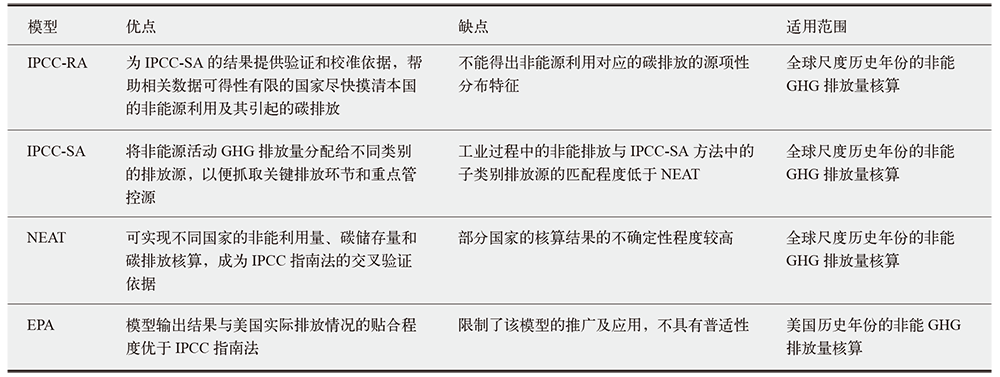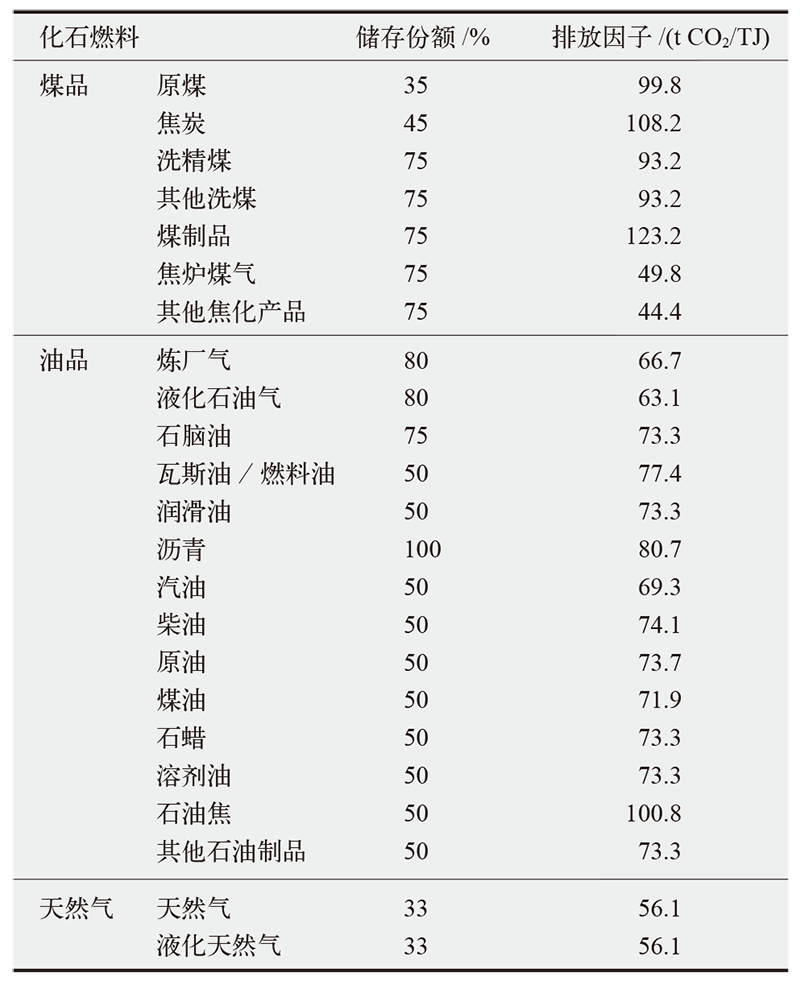| [1] |
中华人民共和国国务院新闻办公室. 《中国应对气候变化的政策与行动(2011)》[EB/OL]. 2011 [2022-10-12]. http://www.gov.cn/jrzg/2011-11/22/content_2000047.htm.
|
|
The State Council Information Office of the People’s Republic of China. China’s policies and actions on climate change (2011)[EB/OL]. 2011 [2022-10-12]. http://www.gov.cn/jrzg/2011-11/22/content_2000047.htm (in Chinese)
|
| [2] |
国务院. 《“十四五”节能减排综合工作方案的通知》[EB/OL]. 2022 [2022-01-24]. http://www.gov.cn/zhengce/content/2022-01/24/content_5670202.htm.
|
|
State Council. Notice of the comprehensive work plan for energy conservation and emission reduction in the 14th Five-Year Plan[EB/OL]. 2022 [2022-01-24]. http://www.gov.cn/zhengce/content/2022-01/24/content_5670202.htm (in Chinese)
|
| [3] |
国家发展和改革委员会. 《关于进一步做好原料用能不纳入能源消费总量控制有关工作的通知》[EB/OL]. 2022 [2022-10-27]. http://www.gov.cn/zhengce/zhengceku/2022-11/01/content_5723281.htm.
|
|
National Development and Reform Commission. Notice on further improving the work of excluding raw material energy use from total energy consumption control[EB/OL]. 2022 [2022-10-27]. http://www.gov.cn/zhengce/zhengceku/2022-11/01/content_5723281.htm (in Chinese)
|
| [4] |
International Energy Agency IEA. Energy balances for OECD countries 1960-2005[M]. Paris, France, 2005
|
| [5] |
Patel M, Neelis M, Gielen D, et al. Carbon dioxide emissions from non-energy use of fossil fuels: summary of key issues and conclusions from the country analyses[J]. Resources, Conservation and Recycling, 2005, 45: 295-209
doi: 10.1016/j.resconrec.2005.05.006
URL
|
| [6] |
Neelis M L, Patel M, Gielen D J, et al. Modelling CO2 emissions from non-energy use with the non-energy use emission accounting tables (NEAT) model[J]. Resources, Conservation and Recycling, 2005, 45: 226-250
doi: 10.1016/j.resconrec.2005.05.003
URL
|
| [7] |
Neelis M L, Patel M, Blok K. CO2 emissions and carbon storage resulting from the non-energy use of fossil fuels in the Netherlands, NEAT results for 1993-1999[J]. Resources, Conservation and Recycling, 2005, 45: 251-274
doi: 10.1016/j.resconrec.2005.05.004
URL
|
| [8] |
Motta S L, Santino D, Ancona P, et al. CO2 emission accounting for the non-energy use of fossil fuels in Italy: a comparison between NEAT model and the IPCC approaches[J]. Resources, Conservation and Recycling, 2005, 45: 310-330
doi: 10.1016/j.resconrec.2005.05.007
URL
|
| [9] |
Weiss M, Neelis M L, Blok K, et al. Non-energy use and related carbon dioxide emissions in Germany: a carbon flow analysis with the NEAT model for the period of 1990-2003[J]. Resources, Conservation and Recycling, 2008, 52: 1252-1265
doi: 10.1016/j.resconrec.2008.06.011
URL
|
| [10] |
Weiss M, Neelis M L, Blok K, et al. Non-energy use of fossil fuels and resulting carbon dioxide emissions: bottom-up estimates for the world as a whole and for major developing countries[J]. Climatic Change, 2009, 95: 369-394
doi: 10.1007/s10584-009-9562-x
URL
|
| [11] |
Park H. Fossil fuel use and CO2 emissions in Korea: NEAT approach[J]. Resources, Conservation and Recycling, 2005, 45: 295-309
doi: 10.1016/j.resconrec.2005.05.006
URL
|
| [12] |
Chen W M, Kim H. Circular economy and energy transition: a nexus focusing on the non-energy use of fuels[J]. Energy & Environment, 2019, 30 (4): 586-600
|
| [13] |
陈东景. 中国非能源利用的CO2储存和释放研究[J]. 干旱区资源与环境, 2009, 20 (5): 89-94.
|
|
Chen D J. Study on CO2 storage and release of non-energy utilization in China[J]. Journal of Arid Land Resources and Environment, 2009, 20 (5): 89-94 (in Chinese)
|
| [14] |
国家发改委气候司. 《省级温室气体清单编制指南》[EB/OL]. 2014 [2019-05-01]. http://www.cbcsd.org.cn/sjk/nengyuan/standard/home/20140113/download/shengjiwenshiqiti.pdf
|
|
Department of Climate Change, National Development and Reform Commission. Guidelines for provincial greenhouse gas inventories[EB/OL]. 2014 [2019-05-01]. http://www.cbcsd.org.cn/sjk/nengyuan/standard/home/20140113/download/shengjiwenshiqiti.pdf (in Chinese)
|
| [15] |
IPCC/IEA/OECD/UNEP. IPCC guideline for national greenhouse gas inventories[R]. UK: IPCC Working Group, 2006
|
| [16] |
IPCC/IEA/OECD/UNEP. IPCC guideline for national greenhouse gas inventories[R]. UK: IPCC Working Group, 1996
|
| [17] |
Krtková E, Danielik V, Szemesová J, et al. Non-energy use of fuels in the greenhouse gas emission reporting[J]. Atmosphere, 2019, 10 (7): 406
doi: 10.3390/atmos10070406
URL
|
| [18] |
Shan Y L, Liu Z, Guan D B. CO2 emissions from China’s lime industry[J]. Applied Energy, 2016, 166: 245-252
doi: 10.1016/j.apenergy.2015.04.091
URL
|
| [19] |
Shan Y L, Zhou Y, Meng J. Peak cement-related CO2 emissions and the changes in drivers in China[J]. Journal of Industrial Ecology, 2019, 23: 959-971
doi: 10.1111/jiec.v23.4
URL
|
| [20] |
Olivier G J J, Peters A H W J. CO2 from non-energy use of fuels: a global, regional and national perspective based on the IPCC Tier 1 approach[J]. Resources, Conservation and Recycling, 2005, 45: 210-225
doi: 10.1016/j.resconrec.2005.05.008
URL
|
| [21] |
Cui D, Deng Z, Liu Z. China’s non-fossil fuel CO2 emissions from industrial processes[J]. Applied Energy, 2019, 254 (11): 113537
doi: 10.1016/j.apenergy.2019.113537
URL
|
| [22] |
IPCC/IEA/OECD/UNEP. 2019 refinement to the 2006 IPCC guidelines for national greenhouse gas inventories[R]. UK: IPCC Working Group, 2019
|
| [23] |
Gielen D J. Potential CO2 emission in Netherlands due to carbon storage in materials and products[J]. Ambio, 1997, 26 (2): 101-106
|
| [24] |
Patel M, Jochem E, Marscheider F, et al. CO2 emission from non-energy use: methodological aspects and a case study for Germany[J]. Ambio, 1999, 28 (2): 175-181
|
| [25] |
Gielen D J, Patel M K. The NEAT model, non-energy use emission accounting tables[R]. Proceedings of The First NEU-CO2 Workshop, 1999
|
| [26] |
Gielen D J, Yagita H. Carbon accounting for Japanese petrochemicals[J]. Mater Cycles Waste Manage, 2002, 4: 51-61
|
| [27] |
Freed R, Mintz C, Lanza R, et al. Analytic framework for analyzing non-energy uses of fossil fuels as petrochemical feedstocks in the USA[J]. Resources, Conservation and Recycling, 2005, 45: 275-294
doi: 10.1016/j.resconrec.2005.05.005
URL
|
| [28] |
国家发展和改革委员会. 《石化和化学工业发展规划(2016—2020年)》[EB/OL]. 2017 [2022-10-20]. https://www.ndrc.gov.cn/fggz/fzzlgh/gjjzxgh/201706/t20170622_1196825.html?code=&state=123
|
|
National Development and Reform Commission. Petrochemical and chemical industry development plan (2016-2020) [EB/OL]. 2017 [2022-10-20 ]. https://www.ndrc.gov.cn/fggz/fzzlgh/gjjzxgh/201706/t20170622_1196825.html?code=&state=123 (in Chinese)
|
| [29] |
国家发展和改革委员会. 《能源发展“十三五”规划》[EB/OL]. 2017 [2022-10-20]. https://www.ndrc.gov.cn/fggz/fzzlgh/gjjzxgh/201705/t20170517_1196766.html?code=&state=123
|
|
National Development and Reform Commission. 13th Five-Year Plan for energy development[EB/OL]. 2017 [2022-10-20]. https://www.ndrc.gov.cn/fggz/fzzlgh/gjjzxgh/201705/t20170517_1196766.html?code=&state=123 (in Chinese)
|
| [30] |
国家发展和改革委员会. 《现代煤化工产业创新发展布局方案》[EB/OL]. 2017 [2022-10-20]. https://www.ndrc.gov.cn/fggz/cyfz/zcyfz/201703/t20170323_1149896.html?code=&state=123
|
|
Modern coal chemical industry innovation and development layout plan. Modern coal chemical industry innovation and development layout plan[EB/OL]. 2017 [2022-10-20]. https://www.ndrc.gov.cn/fggz/cyfz/zcyfz/201703/t20170323_1149896.html?code=&state=123 (in Chinese)
|
| [31] |
国家发展和改革委员会. 《天然气利用政策》[EB/OL]. 2012 [2022-10-20]. http://www.gov.cn/gongbao/content/2013/content_2313190.htm.
|
|
Natural gas utilization policy. Natural gas utilization policy[EB/OL]. 2012 [2022-10-20]. http://www.gov.cn/gongbao/content/2013/content_2313190.htm (in Chinese)
|
 ), 唐旭1,2(
), 唐旭1,2( ), 李忻颖1, 马美艳1, 姜钰卿1, 丁聿1, 马志达1, 任凯鹏3, 张宝生1
), 李忻颖1, 马美艳1, 姜钰卿1, 丁聿1, 马志达1, 任凯鹏3, 张宝生1
 ), TANG Xu1,2(
), TANG Xu1,2( ), LI Xin-Ying1, MA Mei-Yan1, JIANG Yu-Qing1, DING Yu1, MA Zhi-Da1, REN Kai-Peng3, ZHANG Bao-Sheng1
), LI Xin-Ying1, MA Mei-Yan1, JIANG Yu-Qing1, DING Yu1, MA Zhi-Da1, REN Kai-Peng3, ZHANG Bao-Sheng1








